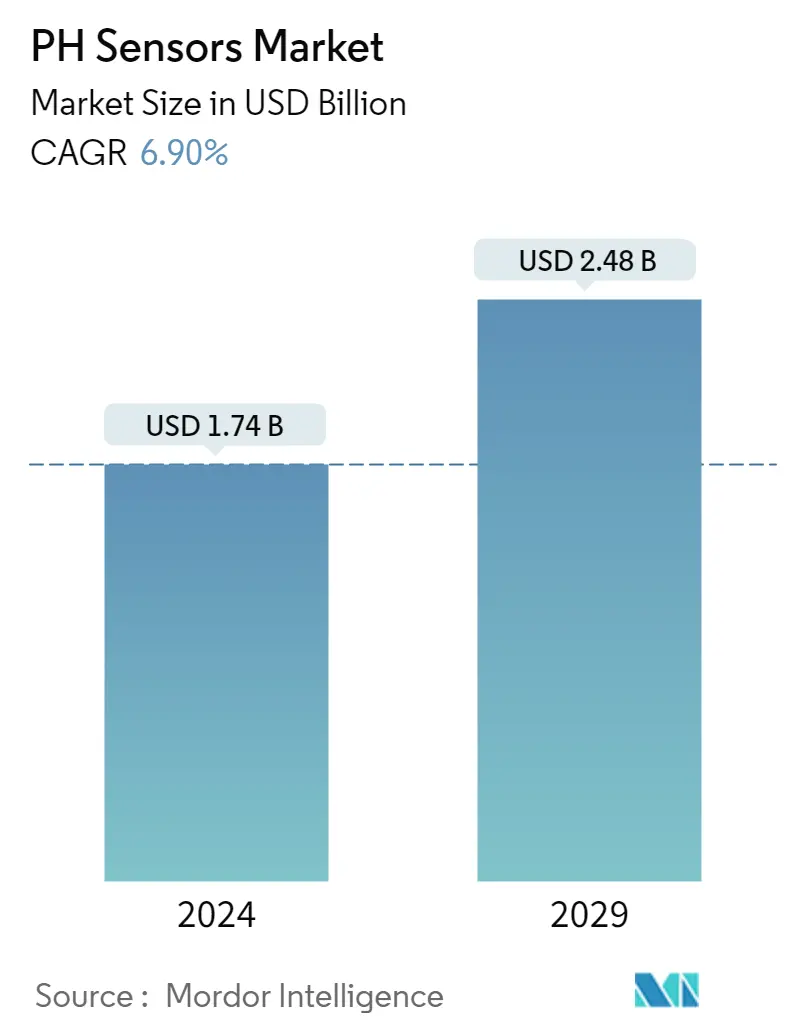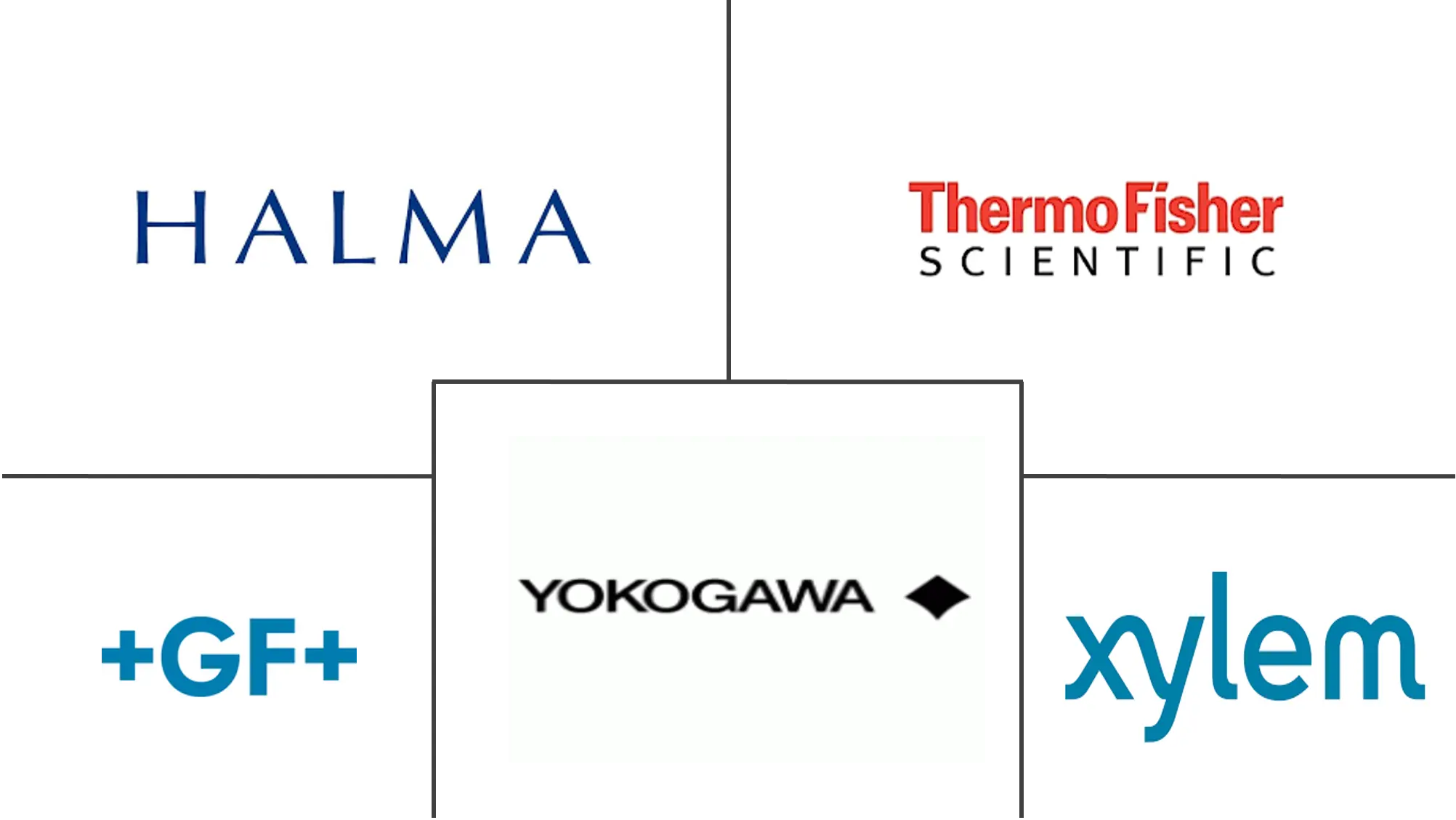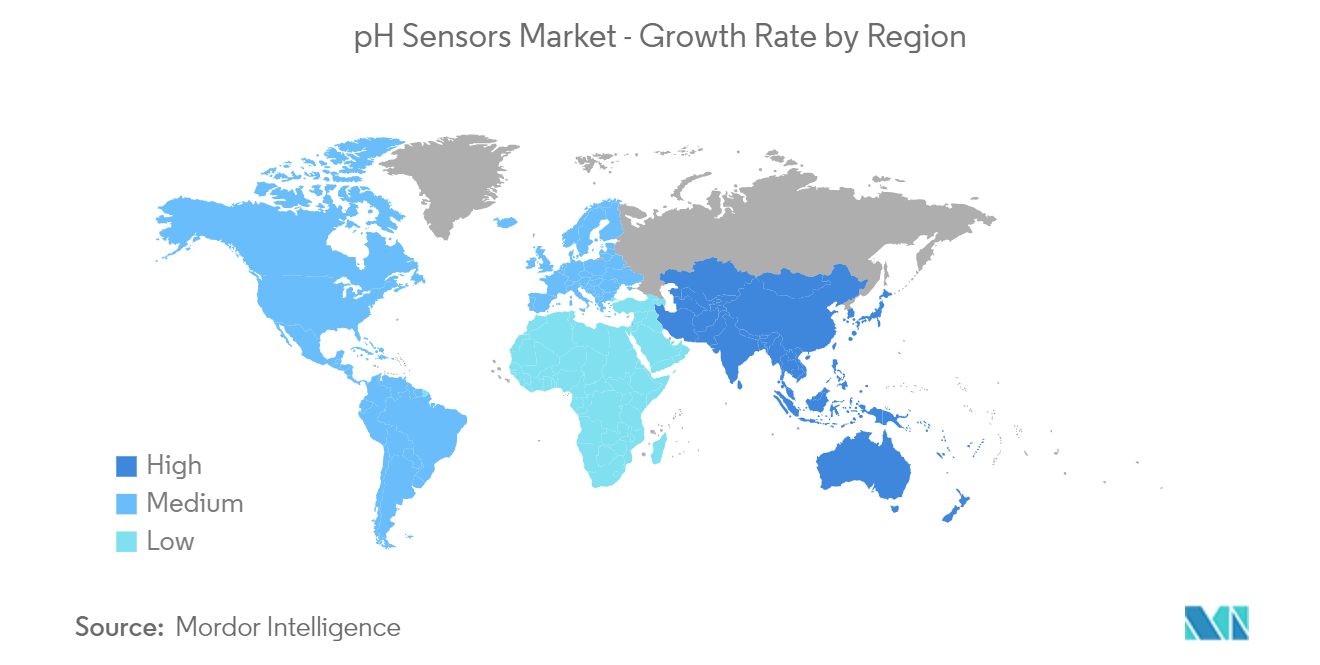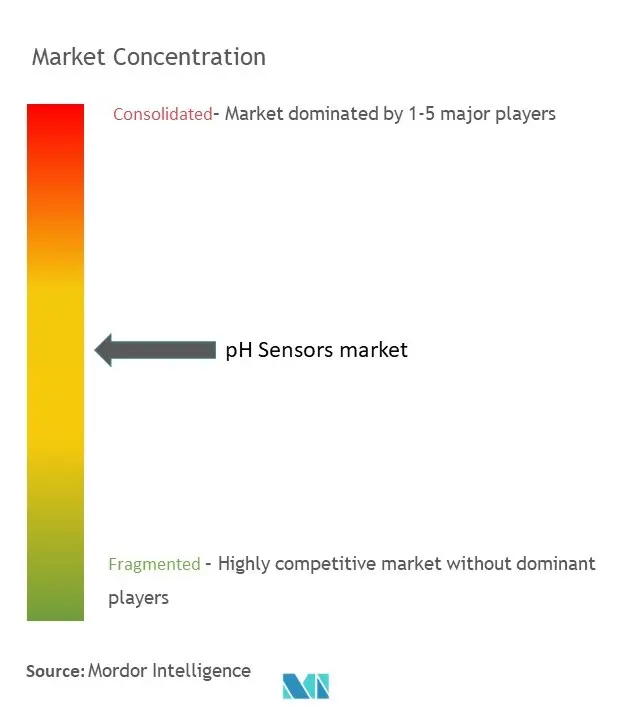pH Sensors Market Size

| Study Period | 2019 - 2029 |
| Market Size (2024) | USD 1.74 Billion |
| Market Size (2029) | USD 2.48 Billion |
| CAGR (2024 - 2029) | 6.90 % |
| Fastest Growing Market | Asia Pacific |
| Largest Market | North America |
Major Players
*Disclaimer: Major Players sorted in no particular order |
pH Sensors Market Analysis
The PH Sensors Market size is estimated at USD 1.74 billion in 2024, and is expected to reach USD 2.48 billion by 2029, growing at a CAGR of 6.90% during the forecast period (2024-2029).
The market growth is driven by the surge in the usage of pH sensors and analyzers in water, wastewater, chromium, and aquaculture treatment plants for formulating precise readings of the oxidation-reduction potential and pH levels. pH sensors monitor drug efficiency and provide optimal pH levels for pharmaceutical manufacturing, further driving the market.
- Further, the growth in the need for industrial automation around the globe is one of the essential elements driving the development of the pH sensors market. Additionally, the government of India sanctioned a PLI scheme for 16 plants for critical starting materials (KSM)/drug intermediates and functional pharmaceutical ingredients (APIs). Installing these 16 plants would result in a total investment of USD 47.01 million. The commercial development of these plants is anticipated to begin by April 2023. Furthermore, the government lately allocated USD 362.32 million to upgrade electronics and IT hardware manufacturing and USD 104.25 million for the Faster Adoption & Manufacturing of Hybrid and Electric automobiles in India (FAME - India).
- ZVEI (German Electrical and Electronic Manufacturers' Association) specified that these circumstances created a favorable business environment for the measurement and process automation industry while raising the need for process analytics instruments, such as pH sensors and analyzers.
- In addition, Stringent government rules over industrial and municipal wastewater disposal are driving the water treatment technology need evolution in recycling and reuse systems which may provide further momentum to create the market studied during the forecast period.
- Furthermore, Municipal authorities widely use wastewater technology in different cities across India for municipal wastewater treatment. According to NITI Aayog, India's market for wastewater treatment plants is expected to rise to USD 4.3 billion by 2025 due to growing demand for municipal and sewage water therapy facilities nationwide.
- Further, countries worldwide have made considerable investments in water infrastructure and desalination projects. For instance, the central government in Chile plans to fund USD 280 million in water infrastructure over the coming years. Countries have also developed to present incentives to promote water and wastewater treatment around the globe, which is anticipated to push the market for pH sensors & analyzers market.
- However, cost constraints and a need for established standards restrain market growth. Many pH sensors, like combination, differential, laboratory, and process pH sensors, are utilized and notice high commercial acceptance. However, there are only so many specified standards for their operation. These technologies are different from each other and lack compatibility. Lack of awareness, less acceptability, and the unjust quality standard these sensors offer could also hinder the market growth.
pH Sensors Market Trends
Water and Wastewater Application to Register Significant Growth
- The water and Wastewater Industry" accounts for the biggest vertical segment in the individual market due to environmental agencies' growth in awareness and environmental situation. Standard applications, like chromium wastewater treatment and aquaculture, largely dependent on precise pH and ORP measurements to provide needed safety standards, are providing constant demand in the market.
- Regions like North America, Europe, and Asia-Pacific, have noticed a significant growth in sustainable energy projects. Water treatment initiatives, like water treatment and desalination activities, are rapidly gaining popularity among municipalities and industrial sectors, developing a substantial need for pH sensors.
- According to Thames Water, the company treated 4.6 billion liters of wastewater daily for the year ending March 2022. Thames Water is established in Reading, Berkshire, with 353 sewage treatment works. It also delivers 2.5 billion liters of drinking water daily to more than 15 million customers in London and the Thames Valley region.
- Globally, growing water treatment plants and situations regarding water scarcity fuel the need for pH sensors from the desalination sector. Water pH gives crucial data for controlling the treatment system for desalination systems. For instance, in November 2022, Daiki Axis Japan, a Water treatment solutions provider, intended to set up its second plant in Haryana, India, with an investment of INR 200 crore, with the plant capacity to produce 1,000 sewage treatment units with Japanese "Johkasou" technology.
- Furthermore, investments from the chemical, water, and wastewater industries are anticipated to increase. For instance, in July 2022, The U.S. Department of Agriculture (USDA) invested USD 13 million to develop access to rural water infrastructure and assemble economic opportunities for people who live and work in colonies or rural and Tribal communities. The investments contain over USD 9 million to help nearly 14,000 people in socially vulnerable communities.
- Further, in August 2022, Biden-Harris Administration introduced EPA-USDA Partnership to deliver Wastewater Sanitation to Underserved Rural America, as such developments will further drive market growth.

Asia Pacific to Experience Significant Market Growth
- Asia-Pacific is anticipated to experience lucrative growth in the ph sensors market over the coming years due to the emerging economy, rising awareness of technological advancements, advances in the pharmaceutical and biotechnology industries, growing awareness in the manufacturing sector, and an increase in government initiatives for funding.
- According to IBEF, the Indian government is expected to spend INR 3.50 lakh crore (USD 46.5 billion) for the "Jal Jeevan" program, which strives to reinforce the current water sources to set up different treatment plants and desalination plants in the coastal regions by 2024. The mission also desires that the existing water supply and connections are functional, water quality is maintained, and sustainable agriculture is achieved.
- Further, in February 2022, According to the data reported by The Energy and Resources Institute (TERI), the country's water demand is anticipated to grow to 1180 BCM by 2050. Such expansion in water in wastewater treatment may further drive the studied market growth in the future.
- In addition, with growing infrastructure projects in China, many water reuse and wastewater treatment policies are demanding pH sensors and analyzers in the country. For example, the statistics from the International Water Association indicate that Beijing, the capital of the People's Republic of China, recycled a quarter of its domestic wastewater and enhanced the treatment of up to 85 percent of industrial wastewater discharge.
- Moreover, growing investments in oil and gas projects further drive the demand for pH measurements in the region. According to IBEF, in May 2022, ONGC announced plans to invest USD 4 billion from FY22-25 to expand its exploration efforts in India.
- Furthermore, in March 2022, the Board of Oil India approved an investment of INR 6,555 crore (USD 839.49 million) for the Numaligarh petrochemical project. In addition, the oil sector's aggregate installed provisional refinery capacity stood at 249.21 MMT, and IOC appeared as the largest domestic refiner with a capacity of 70.05 MMT.

pH Sensors Industry Overview
The pH sensors market is moderately concentrated with the presence of several major players. A few significant players such as Halma PLC, Thermo Fisher Scientific Inc., Xylem Inc., Yokogawa Electric Corporation, and George Fischer Piping Systems Ltd. currently dominate the market in terms of market share. With a prominent market share, these major players focus on expanding their customer bases in various foreign countries. These companies leverage strategic collaborative initiatives to improve their market shares and profitability. The players performing in the market are also acquiring startups working on pH sensors to intensify their product capabilities.
- February 2023 - Rajguru Electronics released the ADIY pH sensor module, a sensor for calculating the potential of hydrogen (pH) in any liquid. It is a low-cost sensor that can precisely measure the hydrogen-ion activity in water-based solutions. Also, it provides better accuracy than pH Indicator solutions and litmus tests. These sensors can easily be integrated with Raspberry Pi and Arduino.
pH Sensors Market Leaders
-
Halma PLC
-
Thermo Fisher Scientific Inc.
-
Xylem Inc.
-
Yokogawa Electric Corporation
-
George Fischer Piping Systems Ltd.
*Disclaimer: Major Players sorted in no particular order

pH Sensors Market News
- November 2023 - Chemists develop new sensor for microvolume pH detection. These microfluidic pH sensors can detect minor variations in the number of protons within a substance, which defines the pH. This allows the measurement of pH with excellent accuracy.
- May 2023 - ANB Sensors, a creator and manufacturer of pH sensor technology has announced their range of AQ and OC Series sensors which are now are fully released and is in distribution.
pH Sensors Market Report - Table of Contents
1. INTRODUCTION
- 1.1 Study Assumptions and Market Definition
- 1.2 Scope of the Study
2. RESEARCH METHODOLOGY
3. EXECUTIVE SUMMARY
4. MARKET INSIGHTS
- 4.1 Market Overview
- 4.2 Industry Value Chain Analysis
-
4.3 Industry Attractiveness- Porter's Five Forces Analysis
- 4.3.1 Bargaining Power of Suppliers
- 4.3.2 Bargaining Power of Buyers
- 4.3.3 Threat of New Entrants
- 4.3.4 Threat of Substitute Products
- 4.3.5 Intensity of Competitive Rivalry
5. MARKET DYNAMICS
-
5.1 Market Drivers
- 5.1.1 Increasing Government Regulations
- 5.1.2 Rising Safety Concerns in Industrial Setups
-
5.2 Market Restraints
- 5.2.1 Cost and Absence of Standardization of pH Sensor Devices
6. MARKET SEGMENTATION
-
6.1 By Type
- 6.1.1 Benchtop Analyzers
- 6.1.2 Portable Analyzers
- 6.1.3 Process Analyzers
-
6.2 By Application
- 6.2.1 Water and Wastewater
- 6.2.2 Medical
- 6.2.3 Oil and Gas
- 6.2.4 Food and Beverages
- 6.2.5 Industrial
- 6.2.6 Other Applications
-
6.3 By Geography***
- 6.3.1 North America
- 6.3.2 Europe
- 6.3.3 Asia
- 6.3.4 Australia and New Zealand
- 6.3.5 Latin America
- 6.3.6 Middle East & Africa
7. COMPETITIVE LANDSCAPE
-
7.1 Company Profiles*
- 7.1.1 Halma Plc.
- 7.1.2 Thermo Fisher Scientific Inc.
- 7.1.3 Xylem Inc.
- 7.1.4 Yokogawa Electric Corporation
- 7.1.5 Georg Fischer Piping Systems Ltd
- 7.1.6 Honeywell International Inc.
- 7.1.7 KOBOLD Messring GmbH
- 7.1.8 Emerson Electric Co.
- 7.1.9 Schneider Electric SE (Foxboro)
- 7.1.10 ABB Ltd
- 7.1.11 Hach Company Inc. (Danaher Corporation)
- 7.1.12 Endress+Hauser AG
- 7.1.13 Mettler-Toledo International Inc.
8. INVESTMENT ANALYSIS
9. FUTURE OF THE MARKET
** Subject To AvailablitypH Sensors Industry Segmentation
The pH sensor is essential for measuring pH and is majorly used in water quality monitoring. This type of sensor can calculate alkalinity and acidity in water and other solutions. When appropriately operated, pH sensors can provide the safety & quality of products and processes in wastewater, manufacturing plants, and other verticals.
The pH Sensors market is segmented by t ype (benchtop analyzers, portable analyzers, process analyzers), application (water and wastewater, oil and gas, medical, food and beverages, industrial), and geography (North America, Europe, Asia Pacific, Latin America and Middle East & Africa). The market sizes and forecasts are provided in terms of value (USD) for all the above segments.
| By Type | Benchtop Analyzers |
| Portable Analyzers | |
| Process Analyzers | |
| By Application | Water and Wastewater |
| Medical | |
| Oil and Gas | |
| Food and Beverages | |
| Industrial | |
| Other Applications | |
| By Geography*** | North America |
| Europe | |
| Asia | |
| Australia and New Zealand | |
| Latin America | |
| Middle East & Africa |
pH Sensors Market Research FAQs
How big is the PH Sensors Market?
The PH Sensors Market size is expected to reach USD 1.74 billion in 2024 and grow at a CAGR of 6.90% to reach USD 2.48 billion by 2029.
What is the current PH Sensors Market size?
In 2024, the PH Sensors Market size is expected to reach USD 1.74 billion.
Who are the key players in PH Sensors Market?
Halma PLC, Thermo Fisher Scientific Inc., Xylem Inc., Yokogawa Electric Corporation and George Fischer Piping Systems Ltd. are the major companies operating in the PH Sensors Market.
Which is the fastest growing region in PH Sensors Market?
Asia Pacific is estimated to grow at the highest CAGR over the forecast period (2024-2029).
Which region has the biggest share in PH Sensors Market?
In 2024, the North America accounts for the largest market share in PH Sensors Market.
What years does this PH Sensors Market cover, and what was the market size in 2023?
In 2023, the PH Sensors Market size was estimated at USD 1.62 billion. The report covers the PH Sensors Market historical market size for years: 2019, 2020, 2021, 2022 and 2023. The report also forecasts the PH Sensors Market size for years: 2024, 2025, 2026, 2027, 2028 and 2029.
pH Sensors Industry Report
Statistics for the 2024 pH Sensors market share, size and revenue growth rate, created by Mordor Intelligence™ Industry Reports. pH Sensors analysis includes a market forecast outlook to 2029 and historical overview. Get a sample of this industry analysis as a free report PDF download.



